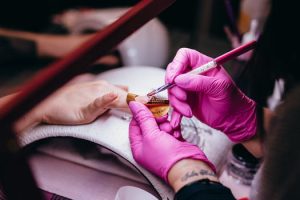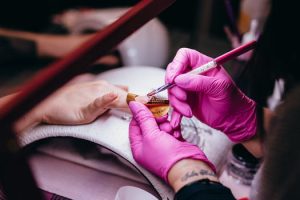
Lots of women enjoy a relaxing mani-pedi at the spa, or just brushing on some nail polish for special occasions. And for teens and tweens, its increasingly a hang-out opportunity.
Turns out, like just about everything else, it’s not that good for the health. It’s especially dangerous for the nail technicians who are exposed for long periods of time, but a recent survey suggests that millions of American teens, tweens and even younger girls are being exposed to a suspected hormone-disrupting chemical at a time when their bodies are rapidly developing and entering puberty.
Researchers at Duke University and Environmental Working Group have found evidence of a suspected endocrine-disrupting chemical widely used in popular nail polishes in the bodies of more than two-dozen women who participated in a biomonitoring study.
Turns out there’s a “toxic trio” – three chemicals — dibutyl phthalate, toluene, and formaldehyde — that are the main culprits.
The study, published in Environment International, found that all women had a metabolite of triphenyl phosphate, or TPHP, in their bodies just 10 to 14 hours after painting their nails. Their levels of diphenyl phosphate or DPHP, which forms when the body metabolizes TPHP, had increased by nearly sevenfold.
Chemicals used in nail salons and their effects on workers (Check out your own polish here)
Products used in nail salons may contain chemicals that can affect worker health. Using these products can expose nail salon workers to chemicals. Workers may breathe in the harmful vapors, dusts, or mists; get the product on their skin or in their eyes; or swallow the product if it is accidentally transferred onto food or cigarettes.
Working in a nail salon exposes workers to many different chemicals each day. These exposures can “add up,” especially when many products are being used at the same time, the products are used day after day, or when there is poor ventilation in the salon. When this happens, workers can get sick. Many nail salon workers also work long hours, which adds to the amount of time they may be exposed to chemicals. These types of exposures may make workers sick immediately or cause effects over time.
Chemical exposures can be controlled. The information below will help you find out what chemicals are in your salon’s products and what steps you can take to reduce exposures and protect worker health. You can find more specific information about the chemicals in your workplace from the safety data sheets (SDS) that manufacturers are required to provide for potentially hazardous salon products.
Hazardous Chemicals Found in Nail Salon Products
Products used in nail salons can contain many chemicals that can have serious health effects.
Some potentially hazardous chemicals, the types of products they can be found in, and how they can affect a worker include:
- Acetone (nail polish remover): headaches; dizziness; and irritated eyes, skin, and throat.
- Acetonitrile (fingernail glue remover): irritated nose and throat; breathing problems; nausea; vomiting; weakness; and exhaustion.
- Butyl acetate (nail polish, nail polish remover): headaches and irritated eyes, skin, nose, mouth, and throat
- Dibutyl phthalate (DBP), (nail polish): nausea and irritated eyes, skin, nose, mouth, and throat. Long-term exposures to high concentrations may cause other serious effects.
- Ethyl acetate (nail polish, nail polish remover, fingernail glue): irritated eyes, stomach, skin, nose, mouth, and throat; high levels can cause fainting.
- Ethyl methacrylate (EMA), (artificial nail liquid): asthma; irritated eyes, skin, nose, and mouth; difficulty concentrating. Exposures while pregnant may affect your child.
- Formaldehyde (nail polish, nail hardener): difficulty breathing, including coughing, asthma-like attacks, and wheezing; allergic reactions; irritated eyes, skin, and throat. Formaldehyde can cause cancer.
- Isopropyl acetate (nail polish, nail polish remover): sleepiness, and irritated eyes, nose, and throat.
- Methacrylic acid (nail primer): skin burns and irritated eyes, skin, nose, mouth, and throat. At higher concentrations, this chemical can cause difficulty breathing.
- Methyl methacrylate (MMA), (artificial nail products, though banned for use in many states): asthma; irritated eyes, skin, nose, and mouth; difficulty concentrating; loss of smell.
- Quaternary ammonium compounds (disinfectants): irritated skin and nose and may cause asthma.
- Toluene (nail polish, fingernail glue): dry or cracked skin; headaches, dizziness, and numbness; irritated eyes, nose, throat, and lungs; damage to liver and kidneys; and harm to unborn children during pregnancy.

